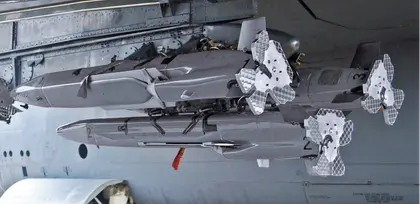Since the arrival of the UK Storm Shadow “bunker busting” cruise missiles in May 2022 and their French SCALP counterparts a couple of months later, they have been responsible for some of the most spectacular and strategically vital strikes against Russian forces.
The missiles have been responsible for long-range hits on targets including the headquarters of Russia’s Black Sea Fleet, destruction of two important naval vessels in the Sevastopol shipyard, an army headquarters a hotel in occupied Berdyansk, the Saky airfield in Crimea and the Chonhar road bridges that link mainland Ukraine to Crimea.
JOIN US ON TELEGRAM
Follow our coverage of the war on the @Kyivpost_official.
While known to be extremely capable, hard to detect munitions, the success of Storm Shadow/SCALP, which are relatively slow-moving cruise missiles, in breaking through the extensive air defense screen deployed by Russian forces surprised many experts.
When the UK and France had originally offered the missiles to Ukraine, the same experts dismissed the ability of Kyiv’s air forces to operate them from their aging Soviet-era aircraft. MBDA, the missile manufacturers, were themselves skeptical.
They suggested it would take six months to modify the Su-24 aircraft designated to be the launch platform – an argument that Germany is also using as one reason for not supplying its Taurus cruise missiles to Ukraine.
Yet modifications were done by MDBA in a few weeks by simply using disused launch pylons from British Tornado multirole combat aircraft. The only limitation seems to be that target designation needs to be entered prior to deployment and cannot be altered in flight by the pilot.

Harris’s Public Performances Have Left Many Doubting What She Stands For
The clues to how the missiles were then used so successfully have been there since their first use in May, when the wreckage of an ADM-160 Miniature Air-Launched Decoy (MALD) was recovered after a Storm Shadow attack against three factories in occupied Luhansk.
What does the MALD do?
The MALD is made by Raytheon as an air launched, expendable decoy missile designed to trigger, confuse, and distract enemy air defenses. It is similar to a cruise missile but can be programmed to simulate the flight pattern and mimic the radar signature of a wide range of aircraft or missiles.
The decoys are especially useful in drawing the attention of the enemy’s air defenses, giving its own infiltrating aircraft and/or missiles a better chance of reaching the target.
The MALD navigates using a combined inertial and GPS guidance system. It weighs around 130 kilograms (290 pounds), is 2.85 meters (9 feet) long, with a wingspan of 1.7 meters (67 inches). It is powered by a Pratt & Whitney TJ‐150 turbojet with a range of nearly 1,000 kilometers (600 miles) and a speed of 0.9 mach.
Its capability is far in excess of Storm Shadow/SCALP and as such has proven to attract the attention of Russian air defenses, since it appears to be a greater immediate threat, allowing the missiles to reach their targets.
The US and Ukraine have never actually declared the presence of the decoys, but the debris found at the same time as successful Storm Shadow strikes leaves no doubt that they are being used.
Some of the recent Russian claims that they have defeated Ukrainian missile attacks, such as that in December near Kherson, were because they had brought down the MALD supporting its big brother.
⚡️The fallen 🇺🇸American decoy missile AGM-160 MALD, probably in the Kherson region.
— 🪖MilitaryNewsUA🇺🇦 (@front_ukrainian) December 1, 2023
They are used at the same time as SS/SCALP-EG, but the carrier aircraft is still unknown, as well as the number received by 🇺🇦Ukraine pic.twitter.com/3kZ7hrXPOn
All of the MALDs encountered in Ukraine have been the older ADM-160B, which is a passive emitter only. Later models, that are only in service with US forces, incorporate other capabilities: MALD-J has an electronic jamming capability, MALI includes an explosive warhead which could be used against an air defense radar emitter, and MASSM (Miniature Autonomous Search and Strike Missile) allows for a large area search for air defense assets.
The other mystery that surrounds the use of the decoys is which platform is being used to launch them. It is assumed that Ukraine is deploying them on the MiG-29 fighters that are used to escort the Su-24 Storm Shadow carriers.
These aircraft have already been modified to carry AGM 88 HARM anti-radar missiles and extended range Joint Direct Attack Munition (JDAM). The experience gained in linking such weapons to Ukraine’s Soviet-era aircraft could have helped pave the way for adding MALD to the capability of these aircraft.
#Ukraine: Now we can finally take a look at how American 🇺🇸 AGM-88 HARM anti-radar missiles are mounted on Ukrainian MiG-29 jets - the missile itself is used with its standard LAU-118/A launcher which is attached to a newly fabricated pylon-adapter, intended specially for AGM-88! pic.twitter.com/Q9IohdkE0N
— 🇺🇦 Ukraine Weapons Tracker (@UAWeapons) September 15, 2022
You can also highlight the text and press Ctrl + Enter






